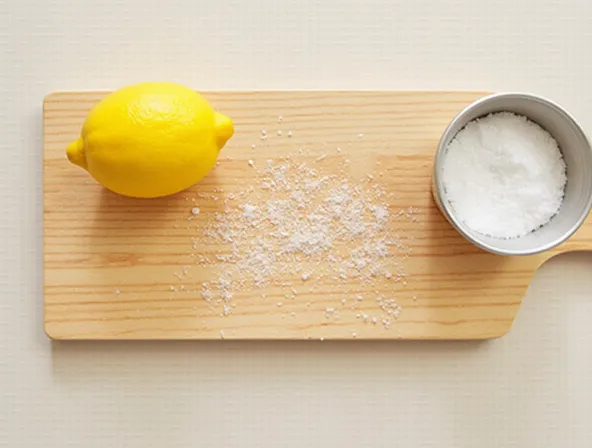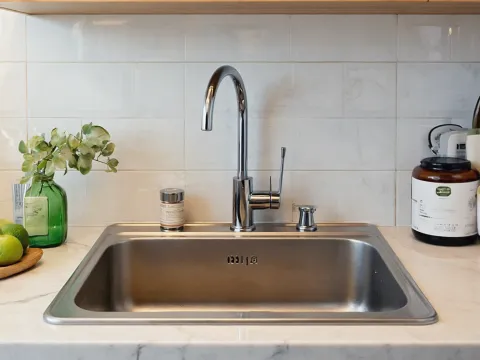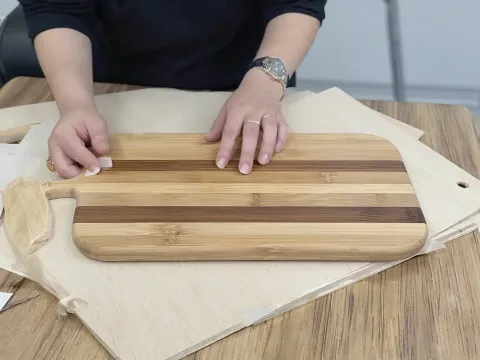Published on May 26, 2025
Last updated: May 26, 2025 · ⏱ 3 min read
Clean Wooden Cutting Boards with Salt & Lemon — Naturally

Understanding the Importance of Cleaning Wooden Cutting Boards
Wooden cutting boards are an essential tool in the kitchen, prized for their durability and aesthetic appeal. However, they require special care to maintain their quality and hygiene. Regular cleaning prevents the buildup of bacteria, removes odors, and prolongs the life of the board. Unlike plastic boards, wooden cutting boards can be more challenging to clean due to their porous nature, which can trap food particles and moisture. That's where the combination of salt and lemon shines as a natural cleaning solution.
The Benefits of Using Salt and Lemon
Using salt and lemon to clean wooden cutting boards offers several advantages. Salt acts as an abrasive agent, helping to scrub away stains and food residues without damaging the wood. It also has natural antibacterial properties, which can help reduce the presence of harmful microorganisms. Lemon, on the other hand, is rich in citric acid, which not only helps to eliminate odors but also acts as a natural disinfectant. The combination of these two ingredients provides a powerful yet gentle cleaning method that is safe for your cutting board.
Materials You Will Need
Before you start cleaning your wooden cutting board with salt and lemon, gather the following materials:
- 1 wooden cutting board
- Coarse salt (kosher or sea salt works best)
- 1 lemon, halved
- Clean cloth or paper towels
- Mineral oil or food-safe wood conditioner (for maintenance)
Step-by-Step Cleaning Process
Cleaning your wooden cutting board with salt and lemon is a straightforward process. Follow these steps for effective results:
Step 1: Prepare the Board
Start by ensuring your wooden cutting board is dry. If it has been used recently, wash it with warm, soapy water and rinse thoroughly. Allow it to air dry completely before proceeding with the salt and lemon cleaning method. This step is crucial, as moisture can hinder the effectiveness of the cleaning process.
Step 2: Apply Salt
Once the board is dry, sprinkle a generous amount of coarse salt over the entire surface. The salt should cover any stained or discolored areas, as well as spots that may have absorbed odors. The coarse texture of the salt will help to lift grime and debris during the scrubbing process.
Step 3: Use the Lemon
Take one half of the lemon and press it onto the salted board. Use the lemon to scrub the surface of the board in circular motions. The acidity of the lemon combined with the abrasiveness of the salt will work together to break down stains and neutralize odors. Ensure you apply enough pressure to effectively clean the surface but be careful not to damage the wood.
Step 4: Rinse and Dry
After scrubbing the board with the lemon, rinse it under warm running water to remove any remaining salt and lemon juice. Be cautious not to soak the board, as excessive water can cause the wood to warp. Once rinsed, dry the board immediately with a clean cloth or paper towel to prevent moisture buildup.
Step 5: Condition the Board
To maintain the integrity of your wooden cutting board, it’s essential to condition it after cleaning. Apply a few drops of mineral oil or a food-safe wood conditioner to a clean cloth and rub it into the surface of the board. This step helps to nourish the wood, preventing it from drying out and cracking. Allow the oil to soak in for several hours or overnight for the best results.
Additional Tips for Maintaining Wooden Cutting Boards
To keep your wooden cutting board in excellent condition, consider these additional maintenance tips:
- Clean your wooden cutting board immediately after use to prevent stains and odors from setting in.
- Avoid soaking the board in water or putting it in the dishwasher, as this can damage the wood.
- Regularly apply mineral oil or wood conditioner to keep the board hydrated and to maintain its appearance.
- For tough stains, consider using a paste made from baking soda and water, in addition to the salt and lemon method.
- Store your cutting board in a dry place, standing upright if possible, to allow air circulation and prevent moisture buildup.
When to Replace Your Wooden Cutting Board
Despite your best efforts in maintaining your wooden cutting board, there may come a time when it needs to be replaced. Signs of wear include deep grooves, cracks, and a persistent odor that cleaning cannot eliminate. If you notice these issues, it may be time to invest in a new cutting board to ensure food safety and hygiene in your kitchen.
The Environmental Benefits of Wooden Cutting Boards
Using wooden cutting boards is not only beneficial for your cooking experience but also for the environment. Wooden boards are biodegradable and made from renewable resources, unlike plastic cutting boards that contribute to pollution and landfill waste. By choosing wooden cutting boards and maintaining them properly, you are making a sustainable choice that benefits both your kitchen and the planet.
Conclusion
Cleaning your wooden cutting board with salt and lemon is a simple, effective, and natural way to maintain its hygiene and prolong its lifespan. By incorporating this cleaning method into your regular kitchen routine, you not only remove stains and odors but also help prevent the buildup of harmful bacteria.
This gentle yet powerful technique avoids the use of harsh chemicals, making it safe for food preparation surfaces. With just a few minutes of effort, you can keep your cutting board looking fresh and functioning well for years to come—naturally and sustainably.
FAQs: Cleaning Cutting Boards

Written by Soufyan from GrowToGrub
Soufyan is a gardening educator and founder of GrowToGrub. Through simple guides, easy recipes, and practical life hacks, he helps everyday growers turn small spaces into sustainable, delicious, and chemical-free living.


